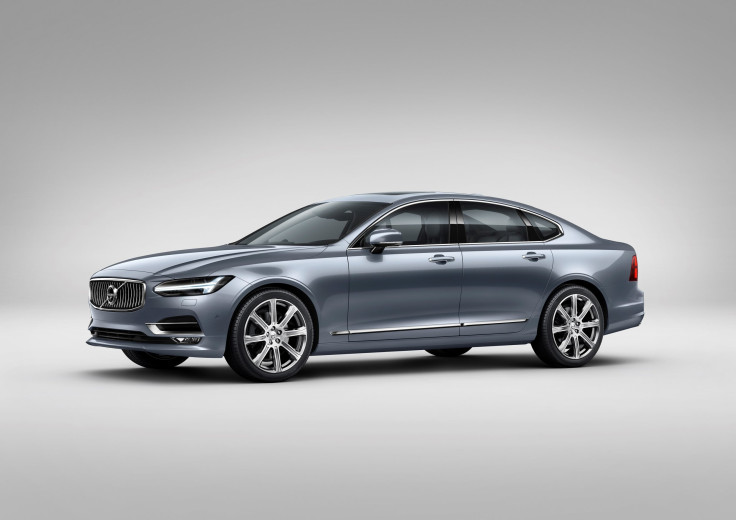Volvo’s S90 Is An Important Test Of The Carmaker’s $11 Billion Reinvention

When Volvo rolls into the 2016 Detroit Auto Show next month it will bring with it the most important release since the Swedish automaker was acquired by one of China’s largest automakers five years ago. The 2017 Volvo S90 marks Volvo’s return to being, well, Volvo, after a decade in the shadow of its former master Ford.
With its first post-Ford sedan, Volvo aims to lure wealthy customers away from the BMW 6 Series, the Jaguar XF, the Audi A6 and, most notably, the 2017 Mercedes E-Class that’s also premiering an all-new look in Motor City after the holidays.
Whether the S90 can put Volvo -- better known historically for its safe station wagons and compact cars -- on the same stage as its German counterparts will depend largely on how well consumers embrace the car’s technological features, which include lane-keeping assist and a large-animal detection system to avoid day or nighttime collisions.
“Our idea was to bring something entirely new to this rather conservative segment,” the company’s design chief Thomas Ingenlath said in a statement.
After the relative success of the 2016 Volvo XC90 three-row small-engine SUV, which has won accolades for the innovative safety features that have long defined the car company, it appears that Volvo is on its way toward getting its Scandinavian groove back, says Stephanie Brinley, senior analyst at IHS Automotive.
“After the sale from Ford to Geely, Volvo needed to step back and evaluate itself,” says Brinley. “They’ve needed to be very clear about what the brand is about, and Geely has been giving Volvo space to do that.”
Ford bought Volvo’s car division in 1999 for $6.45 billion as part of a failed effort to increase its global presence through a series of acquisitions, which included Volvo, Jaguar and Land Rover. The Dearborn, Michigan, maker of Mustangs and F-Series pickup trucks struggled to turn the brands around. It eventually sold them off during the global economic crisis that sent the global industry into a tailspin. In 2008, Ford sold Jaguar and Land Rover to Indian auto giant Tata Motors, and it sold Volvo to China’s Zhejiang Geely Holding Group in 2010 for $1.8 billion.

Two years later, Volvo announced that the second generation XC90 would enter production in 2014. It was the first of a raft of vehicles the company plans to produce through 2020 as part of Geely's $11 billion gamble to reinvigorate Volvo's brand globally. The cars will be built on Volvo’s so-called Scalable Product Architecture, which allows the company to build different four-cylinder engine body types using the same adjustable platform for different vehicle lengths. This allows Volvo to avoid the money-sucking practice of building different platforms for different body types and is part of a larger trend in car production. The XC90 was the first Volvo since Ford’s ownership of the automaker to be built without any Ford components; the S90 is the second.
“What [Volvo] lost under Ford was independence,” says Brinley. “It was part of the Ford network, and it shared development with Ford. You didn’t hear much about Volvo independently.”

Volvo is hoping that will now change. It wants Americans to associate the brand with its European roots, in much the same way Mercedes-Benzes are considered German cars even if they’re produced in Tuscaloosa, Alabama. Volvo has been showing up to car shows in recent years with bolder, less-boxy design cues -- including new signature “Hammer of Thor” style T-shaped LED headlights -- while emphasizing that its cars are still designed and engineered at its Gothenburg, Sweden, headquarters.
Last year, Volvo unveiled its Concept Estate station wagon at the Geneva Motor Show, and last week Volvo’s Ingenlath hinted to British car magazine Auto Express that a two-door sporty coupe version of the S90 would be out by 2020.
That’s not to say Volvo doesn’t take cues from its Chinese owners.
While it plans to open a $500 million factory in the near future in the U.S. as part of its goal of selling 100,000 cars there annually (up from 56,000 last year, less than half of what it sold pre-Ford), it’s already producing cars in China. The Volvo S90 in China will be longer, owning to local consumer tastes for roomier back-seating, and a small number of those Chinese made Volvo S90s will join the Buick Envision crossover SUV, as the first Chinese-manufactured passenger cars to hit the U.S. market next year.
© Copyright IBTimes 2024. All rights reserved.






















